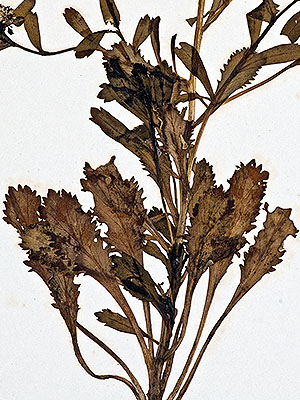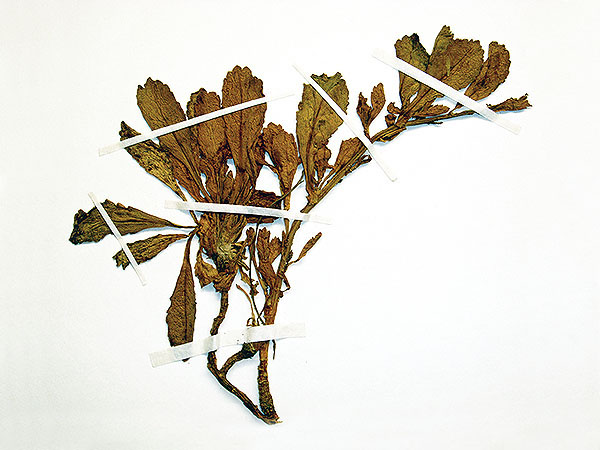This species was restricted to the Sandstone Fynbos of the Cape Peninsula of the Western Cape Province, South Africa; it was last seen in 1970 and might be extinct now.
*********************
edited: 02.05.2022

This species was restricted to the Sandstone Fynbos of the Cape Peninsula of the Western Cape Province, South Africa; it was last seen in 1970 and might be extinct now.
*********************
edited: 02.05.2022
Drummond’s Scurvy Grass (Lepidium drummondii)
Drummond’s Scurvy Grass was described in 1906, it was restricted to the vicinity of the Swan River in Western Australia.
The species was last collected in 1846 and is now extinct.
*********************
References:
[1] B. Dell; J. J. Havel; N. Malajczuk: The Jarrah Forest: A complex mediterranean ecosystem. Dordrecht; Boston: Kluwer Academic Publishers 1989
*********************
edited: 16.09.2019
The Fruit Rockcress is known only from the Undine Falls in the Yellowstone national Park in Wyoming, USA; it has only ever been found once.
This might in fact not be an actual species but a robust form of another species or maybe a hybrid form.
*********************
edited: 25.04.2022
Waitakere Scurvy Grass (Lepidium amissum)
The Waitakere Scurvy Grass was described in 2013 in the curse of a genus revision, it is known only from four herbarium sheets one of which had been collected in 1870 and the other three in 1917.
The species was restricted to the coastlines of the Waitakere Ranges on the North Island of New Zealand. [1]
*********************
References:
[1] P. J. de Lange; P. B. Heenan; G. J. Houliston; J. R. Rolfe; A. D. Mitchell: New Lepidium (Brassicaceae) from New Zealand. PhytoKeys 24: 1-147. 2013
*********************

*********************
edited: 16.09.2019
Remy’s Scurvy Grass (Lepidium remyi)
Remy’s Scurvy Grass or Remy’s Pepperweed was described in 1890, it was endemic to the island of Hawai’i, the largest of the Hawaiian Islands, were it apparently was only ever known from a single site somewhere on the slopes of the Hualalai volcano. It was collected sometimes between 1851 and 1855, another collection from the year 1949 is thought to possibly also represent this species.
The species was given the status of a variety of Lepidium bidentatum Montin in 1969, and the photo below shows a variety of that species that is endemic to the Hawaiian Islands, the Hawaiian Scurvy Grass (Lepidium bidentatum var. o-waihiense (Cham. & Schltdl.) Fosberg).
Remy’s Scurvy Grass might have been nothing but a extreme form of another Hawaiian Scurvy Grass species, or it might have been an extremely rare endemic species, whatever case, it is now most likely extinct.
*********************
[1] F. R. Fosberg: Miscellaneous notes on Hawaiian plants – 5. Bishops Museum Occasional Papers 24(2): 1-24. 1869
*********************

*********************
edited: 16.09.2019
Obtuse-glanded Scurvy Grass (Lepidium obtusatum)
The Obtuse-glanded Scurvy Grass was described in 1892, the species were known from two populations on the North Island of New Zealand: one at the coastline of the Waitakere Ranges, and another one on the Miramar peninsula on the southeastern side of the city of Wellington.
The first of these population disappeared around 1917, the other one from Wellington was last seen in 1950, thus the species is now considered extinct.
The species is furtermore known to have hybridized with a close relative, Cook’s Scurvy Grass (Lepidium oleraceum G. Forst. ex Sparrm.) with which it grew sympatrically at at least one site, Seatoun, a suburb of Wellington. [1]
***
For a very short glimpse of time this species was about to “rise from the dead” – seeds, collected from a specimen that had been collected in the late 1930s was sown in 1993, and it indeed begun to germinate!
However, this experiment did not succeeded because the seedlings died shortly after.
*********************
References:
[1] P. J. de Lange; P. B. Heenan; G. J. Houliston; J. R. Rolfe; A. D. Mitchell: New Lepidium (Brassicaceae) from New Zealand. PhytoKeys 24: 1-147. 2013
*********************

*********************
edited: 16.09.2019
San Luis Watercress (Rorippa coloradensis)
The San Luis Watercress was described in 1972 on the basis of a herbarium specimen which had been collected in 1875 at some unknown locality in southern Colorado, USA
The species, which is quite conspicuous because of its rather large flowers, probably grew along the margins of lakes and rivers.
The San Luis Watercress is considered extinct.
*********************
Referenzen:
[1] Ronald L. Stuckey: Taxonomy and distribution of the genus Rorippa (Cruciferae) in North America. SIDA 4(4): 279-430. 1972
*********************
edited: 04.02.2020